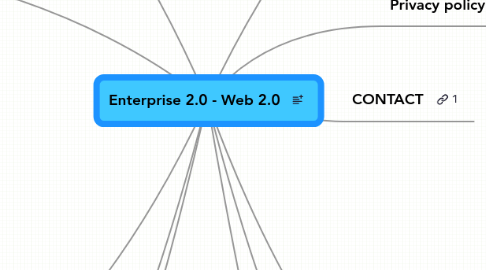
1. Green benefits
1.1. Energy use reduction
1.2. Paper use reduction
1.3. Cost savings maintenance
2. Network
2.1. Co-workers
2.1.1. ATAWAD - Any Time Any Where Any Device
2.1.1.1. Access to information
2.1.1.2. Editing
2.1.1.3. Sharing information
2.1.1.4. Publishing information
2.1.2. UGC - User Generated Content
2.2. Multiple Business partners
2.2.1. Collective intelligence
2.2.1.1. Design
2.2.1.2. Marketing
2.2.1.3. Innovation
2.2.1.4. Funding
2.2.1.5. Media
2.3. SaaS providers
2.3.1. Hosted solutions
3. Value (marketing)
3.1. Interactivity
3.1.1. RichMedia
3.1.1.1. Podcast - Audiocast
3.1.1.2. Videocast
3.1.1.3. Screencast
3.1.1.4. Slidecast
3.1.2. Survey in Real-Time
3.1.3. Participation
3.1.3.1. Comments
3.1.3.2. Cobrowsing
3.1.3.3. Blogging
3.1.3.4. Micro Blogging
3.1.4. Partition of contents - RSS
3.1.5. Social indexing - TAG cloud
3.2. Collaboration
3.2.1. CO Design
3.2.2. CO Padding
3.2.3. CO Scheduling
3.2.4. Use of knowledge
3.2.5. Remote presentations
3.3. Efficiency
3.3.1. Aggregation of contents
3.3.2. Transfer of information
3.3.3. Synchronization
3.3.4. Backups
4. The stakes
4.1. Conversion rate
4.2. Productivity
4.3. Cost savings
5. Principles
5.1. Exchange
5.2. Sharing
5.3. open-minded
6. Uses
6.1. I work online
6.1.1. Standard tools
6.1.1.1. Web office
6.1.1.1.1. ZOHO
6.1.1.1.2. Box.net
6.1.1.1.3. Drop.io
6.1.1.1.4. Etherpad
6.1.1.1.5. mindmeister
6.1.1.1.6. SlideRocket
6.1.1.2. Project management
6.1.1.2.1. Basecamp
6.1.2. Business driven solutions
6.1.2.1. Management
6.1.2.1.1. Seminars, meetings, training
6.1.2.1.2. BI
6.1.2.1.3. Reporting
6.1.2.2. Marketing/CRM
6.1.2.2.1. Salesforce
6.1.2.2.2. AdSense
6.1.2.3. HRM
6.1.2.3.1. SuccessFactors
6.1.2.4. Accounting
6.1.2.4.1. NETSUITE
6.1.2.5. Invoicing
6.1.2.5.1. FreshBooks
6.1.2.6. SCM
6.1.2.6.1. Procurement
6.1.2.6.2. Inventory
6.1.2.6.3. PLM - Product Life Management
6.1.2.7. IT management
6.1.2.7.1. Backup
6.1.2.7.2. BPM - Business Process Management
6.1.2.7.3. Identity
6.1.2.7.4. Monitoring
6.2. I publish in real-time
6.2.1. Information Management
6.2.1.1. WIKI
6.2.1.1.1. MediaWiki
6.2.1.1.2. SocialText
6.2.1.1.3. IBM - Lotus Connections
6.2.1.2. CMS
6.2.1.2.1. Joomla
6.2.1.3. Blog
6.2.1.3.1. TypePad
6.2.2. Social Bookmarking
6.2.2.1. delicious
6.2.3. Content Management
6.2.3.1. YouTube
6.2.3.2. Flickr
6.2.3.3. SlideShare
6.2.4. Social networking
6.2.4.1. MySpace
6.2.4.2. Facebook
6.3. I personalize my portal
6.3.1. Netvibes
6.3.1.1. Aggregation of feeds
6.3.1.2. Aggregation of services
6.4. I virtualize my operating system
6.4.1. Glide
7. Privacy policy
7.1. TRUSTe
7.2. Safe Harbor
8. CONTACT
9. Business model
9.1. SaaS - Software on Demand
9.1.1. Principles
9.1.1.1. Outsourcing
9.1.1.1.1. Hardware
9.1.1.1.2. Software
9.1.1.1.3. Services
9.1.1.2. Sharing of end-user licenses
9.1.2. ONLY operational expenditure
9.1.2.1. Subscription
9.1.3. NO capital expenditure
9.2. Donation
9.3. Advertisement
9.3.1. Affliliation
9.3.2. CPC
9.3.3. CPM
10. Long Tail strategy
11. Architecture
11.1. World Wide Computer vs Personal Computer
11.1.1. SaaS
11.1.2. Infoware
11.1.3. WebTop vs DeskTop
11.2. Technology
11.2.1. Top Level
11.2.1.1. RIA
11.2.1.1.1. Flex
11.2.1.1.2. Flash
11.2.1.1.3. AJAX
11.2.1.2. Social web
11.2.1.2.1. Participation
11.2.1.2.2. Wiki, blogs, CMS
11.2.1.2.3. Folksonomy
11.2.1.3. SOA
11.2.1.3.1. Web Services
11.2.1.3.2. Mashups - widgets
11.2.1.3.3. RSS
11.2.1.3.4. Semantic Web - Web 3.0 Microformats
11.2.2. Basic Level
11.2.2.1. Oriented Object Technology
11.2.2.2. XML
11.3. Cloud computing
11.3.1. SaaS - Software as a Service
11.3.1.1. Self-Service Based Usage Model
11.3.1.1.1. Users
11.3.1.1.2. IT Team
11.3.1.2. Consumption based model vs licence per device
11.3.1.2.1. Integration with billing systems
11.3.1.3. One-to-many delivery model
11.3.1.3.1. Single instance - multi-tenant architecture
11.3.2. PaaS - Platform as a Service
11.3.2.1. Dynamic computing infrastructure
11.3.2.1.1. Standardization
11.3.2.1.2. Scalablability
11.3.2.1.3. Security
11.3.2.2. Minimally or Self-Managed Platform
11.3.2.2.1. Deploying services
11.3.2.2.2. Reserving resources
11.3.2.2.3. Allocation to multiple groups of users
11.3.2.2.4. Access control to resources
11.3.2.2.5. Integrated development environment
11.3.3. IaaS - Infrastructure as a Service
11.3.3.1. Resizable compute capacity
11.3.3.2. Core database functions
11.3.3.2.1. Data querying
11.3.3.2.2. Data indexing
11.3.3.3. Storage
11.3.3.4. Content delivery
11.3.3.5. Processing vast amounts of data
